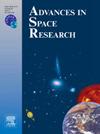印度东北地区东喜马拉雅结带晴朗天气大气电场变化的研究
IF 2.8
3区 地球科学
Q2 ASTRONOMY & ASTROPHYSICS
引用次数: 0
摘要
本文研究了在东喜马拉雅构造带南赛(27.69°N, 95.85°E)记录的晴天大气电场(AEF)电位梯度(PG)的变化。这项工作基于从2017年11月到2019年4月的99个晴天收集的数据。我们的目标是评估南赛地区PG的一般特征,并进一步探索破译PG中地震相关特征的可能性。我们的分析表明,公平天气PG的平均日变化在约14:00 UT达到峰值。季节分析表明,PG值在冬季最大,其次是春分和夏季。PG的这些特征可以从南赛的气象参数变化、空气污染水平和地理位置(即附近的雅鲁藏布江及其周围的茂密森林)来解释。我们进一步报道了2017年11月17日发生在主中央逆冲附近的盲断层上的6.4级地震前PG的显著变化。PG在事件发生前约7小时观察到持续约2小时的海湾形负异常。异常超过平均晴朗天气PG的2σ极限,地震日没有明显的气象变化。认为PG异常与地震有关,与局地气候变化无关。这项研究不仅提供了更好地了解该地区晴朗天气PG的一般变化,而且还强调了AEF测量作为地震事件潜在指标的重要性,提前几小时感知作为前兆信号。本文章由计算机程序翻译,如有差异,请以英文原文为准。
Investigation of fair weather atmospheric electric field variations from the Eastern Himalaya Syntaxis in North-East region of India
We examine here variations of fair weather atmospheric electric field (AEF) referred to as potential gradient (PG), recorded at Namsai (27.69°N, 95.85°E) in the Eastern Himalaya Syntaxis. The work is based on data collected over 99 fair weather days spanning from November 2017 to April 2019. We aim to assess the general characteristics of PG over Namsai and further explore the possibility of deciphering seismic-associated signatures in PG. Our analysis indicates that the mean diurnal variation of fair weather PG peaks at ∼14:00 UT. Seasonal analysis shows that PG values maximized during the winter, followed by the equinox and summer. These characteristics of PG are explained in terms of variations in meteorological parameters, air pollution level, and geographical location of Namsai, i.e., the Brahmaputra river nearby and the deep forest surrounding it. We further report a significant variation in PG before the Mw 6.4 earthquake on November 17, 2017, which occurred in a blind fault near the Main Central Thrust. PG showed a bay-shaped negative anomaly lasting ∼2 h, observed ∼7 h before the event. The anomaly exceeded the 2σ limit of mean fair weather PG. The earthquake day was devoid of any significant meteorological changes. It is suggested that the PG anomaly was associated with earthquake rather than local weather changes. This study not only provides better insights into the general variability of fair weather PG over this region but also highlights the importance of AEF measurements as a potential indicator of seismic events, sensing as precursory signals several hours ahead.
求助全文
通过发布文献求助,成功后即可免费获取论文全文。
去求助
来源期刊

Advances in Space Research
地学天文-地球科学综合
CiteScore
5.20
自引率
11.50%
发文量
800
审稿时长
5.8 months
期刊介绍:
The COSPAR publication Advances in Space Research (ASR) is an open journal covering all areas of space research including: space studies of the Earth''s surface, meteorology, climate, the Earth-Moon system, planets and small bodies of the solar system, upper atmospheres, ionospheres and magnetospheres of the Earth and planets including reference atmospheres, space plasmas in the solar system, astrophysics from space, materials sciences in space, fundamental physics in space, space debris, space weather, Earth observations of space phenomena, etc.
NB: Please note that manuscripts related to life sciences as related to space are no more accepted for submission to Advances in Space Research. Such manuscripts should now be submitted to the new COSPAR Journal Life Sciences in Space Research (LSSR).
All submissions are reviewed by two scientists in the field. COSPAR is an interdisciplinary scientific organization concerned with the progress of space research on an international scale. Operating under the rules of ICSU, COSPAR ignores political considerations and considers all questions solely from the scientific viewpoint.
 求助内容:
求助内容: 应助结果提醒方式:
应助结果提醒方式:


